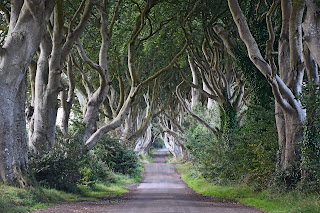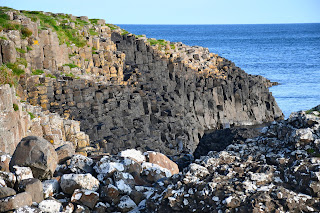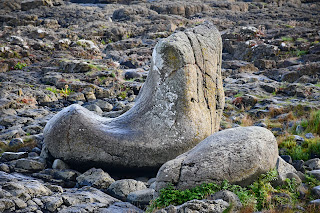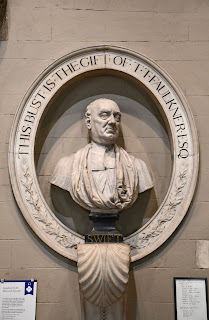Ireland: Day 2 – County Antrim and Dublin
Overpowered by jetlag, I fell asleep very early yesterday; indeed, I remember it was still bright outside when I nodded off. The jetlag, however, worked to my advantage: I arrived again by the Dark Hedges at half past six as one of the first few tourists. Only this way did I finally manage to appreciate the solemn beauty of the mighty old beech trees.
From the Dark Hedges,
I drove on to the Giant’s Causeway. It was still very early, so the parking lot
at the Visitor Centre was closed. I thus had to drive up the road for a few
hundred metres to the Causeway Coast Way Car Park, which is open 24/7 (and
charges an exorbitant 10 pounds for parking at the location). The path to the
Giant’s Causeway is quite long and not particularly well marked. Around the
Visitor Centre and hotel, one suspects that the lack of signage might be caused
by a desire to trick people into staying and buying pointless services.
Legend has it that the
giant Fionn mac Cumhaill built the causeway to reach
Scotland, whose own resident giant named Benandonner had challenged him to a fight. When he got to Scotland,
however, Fionn realised that Benandonner was much bigger than him. Disguising
himself as a baby by having his wife tuck him into a cradle, Fionn tricked the
other giant into thinking that this ‘baby’ belonged to Fionn and that Fionn
himself was a giant among giants. Benandonner fled back to Scotland and
destroyed the causeway so that Fionn could not follow him.
I descended to the
Causeway along the most popular path, and continued along the coast until I
found another path rising steeply to the top of the cliffs. The loop brought me
back to the car park where I had left my car. Not yet turning south, I made a
brief stop by Dunluce Castle, a medieval ruin on a rock above the sea that is connected
to the mainland by a small bridge. The castle was not open yet, but I caught
the most striking views from a nearby bend, where one can see the walls perched
on cliffs that plunge into the waters.
My original plan for
the day was to see Belfast, but having already made that excursion yesterday, I
decided to drive farther south and see Dublin instead. The drive took almost
three hours, during which I managed to discover multiple radio stations in both
UK and Ireland that play a nice selection of classical music. More importantly,
perhaps, I also found a gas station, which was quite useful with my balance
standing at less than one eighth of a tank.
Among the city’s major
attractions are Saint Patrick’s Cathedral and Christ Church Cathedral. Both
were established in the Middle Ages when Catholicism was the only denomination
on the island, and both now belong to the Church of Ireland. Christ Church
Cathedral was founded around 1030 by the Viking King Sigtrygg Silkbeard and was
rebuilt in stone under the Norman Richard de Clare (also called Strongbow). It
was the latter who began the centuries-long domination of Ireland by the
English, and his tomb remains on display on the right of the cathedral’s nave.
The establishment of Saint
Patrick’s Cathedral in 1191 drew the two religious institutions into a dispute
over jurisdiction and status, which was only resolved in 1300. The agreement
instituted multiple measures that reaffirmed the equality of the two cathedrals
in most cases, while also giving slight priority to the elder church. Nowadays,
Saint Patrick’s Cathedral is considered the national cathedral of the Church of
Ireland, while Christ Church Cathedral serves as the cathedral of the Diocese
of Dublin and Glendalough.
Perhaps the major
attraction at Saint Patrick’s Cathedral is Jonathan Swift, who once served as
the cathedral’s dean. The cathedral has both his bust and memorial plaque, as
well as copies of his death mask, which are displayed in a cabinet between the
pillars. Meanwhile, Christ Church Cathedral is famous for its crypt, which is
said to be the largest cathedral crypt in Britain and Ireland. An interesting
feature of the ground level at Christ Church is the floor: featuring
prominently on the tiles are the shapes of “fox pilgrims,” which have become a
symbol of the church.
After visiting the two cathedrals, I stopped by Dublin Castle. I did not venture into the interior of the building and stayed at the courtyard, which is flanked by multiple ornate gates. The best view of the castle, however, is from Dubh Linn Garden, which lies to the south of the main tower. Once I had been there, only Trinity College remained on my itinerary. I was surprised by how pretty and busy it was – a combination that does not seem very conducive to studying. I ended the day at another Airbnb about an hour’s drive north of the city centre, in Boyne Valley.































































Comments
Post a Comment